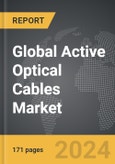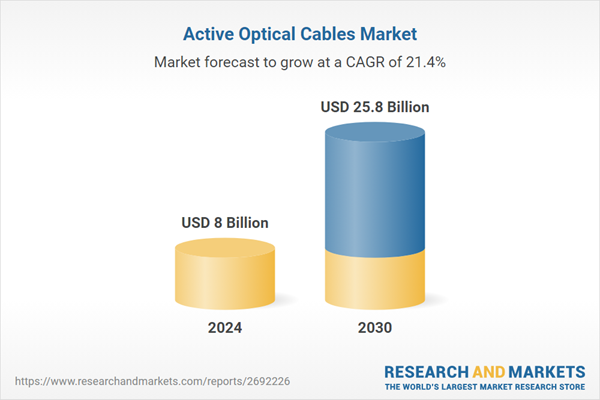The global market for Active Optical Cables was valued at US$8.0 Billion in 2024 and is projected to reach US$25.8 Billion by 2030, growing at a CAGR of 21.4% from 2024 to 2030. This comprehensive report provides an in-depth analysis of market trends, drivers, and forecasts, helping you make informed business decisions. The report includes the most recent global tariff developments and how they impact the Active Optical Cables market.
One of the key advantages of AOCs over traditional copper cables is their reduced susceptibility to electromagnetic interference (EMI), which ensures more stable and reliable connections, particularly in industrial settings. The optical fiber construction of AOCs supports higher bandwidths, facilitating faster data transfers. These cables are also thinner and lighter than copper cables, which makes installation and management easier, especially in tight spaces. Additionally, the non-conductive nature of AOCs reduces the risk of electrical shocks, enhancing safety in sensitive environments. However, there are some drawbacks to AOCs, including their higher cost due to the sophisticated technology they incorporate. They also require specific equipment for termination and connections, adding to the initial investment. Moreover, AOCs are physically more fragile than copper cables, making them vulnerable to damage from bending or crushing, which can pose challenges in environments with high physical stress.
Choosing the right AOC involves several considerations, including the type of cable - single-mode for longer distances and multi-mode for shorter distances. The network's speed requirements should also match the capacity of the AOC, which can range from 1Gbps to 100Gbps. The length of the cable is another important factor, with options ranging from 1 meter to 100 meters to suit different connectivity needs. Beyond these technical specifications, understanding the distinct types of AOCs, such as Plastic Optical Fiber (POF) for cost-sensitive, short-range applications, is crucial for making informed decisions. Ultimately, despite the higher costs and physical sensitivities, the benefits of AOCs, such as superior bandwidth, reduced EMI, and enhanced safety, make them a valuable investment for upgrading and future-proofing network infrastructures, particularly as demands for faster and more reliable data transmission continue to grow.
Segments: Protocol (InfiniBand, Ethernet, DisplayPort, HDMI, USB, PCIe, Other Protocols); Connector Type (QSFP, CXP, CDFP, CFP, SFP, Other Connectors); Application (Data Center, Consumer Electronics, High-Performance Computing (HPC), Telecommunication, Personal Computing, Other Applications).
Geographic Regions/Countries: World; United States; Canada; Japan; China; Europe (France; Germany; Italy; United Kingdom; Spain; Russia; and Rest of Europe); Asia-Pacific (Australia; India; South Korea; and Rest of Asia-Pacific); Latin America (Argentina; Brazil; Mexico; and Rest of Latin America); Middle East (Iran; Israel; Saudi Arabia; United Arab Emirates; and Rest of Middle East); and Africa.
The analysts continuously track trade developments worldwide, drawing insights from leading global economists and over 200 industry and policy institutions, including think tanks, trade organizations, and national economic advisory bodies. This intelligence is integrated into forecasting models to provide timely, data-driven analysis of emerging risks and opportunities.
Active Optical Cables- Key Trends and Drivers Summarized
Active Optical Cables (AOCs) are specialized fiber optic cables that incorporate active electronic components to amplify or regenerate signals, making them ideal for high-demand environments such as supercomputing clusters and large data centers. These cables predominantly use multimode fiber optic technology, which allows them to carry multiple signals at different wavelengths simultaneously, significantly enhancing signal reach while minimizing loss. AOCs are available in various lengths and capacities, ranging from 10 Gigabit Ethernet versions that handle speeds up to 10 Gbps over distances of up to 300 meters, to more robust models designed for even greater distances and higher speeds. This flexibility makes AOCs highly adaptable to specific project requirements or infrastructure needs, providing a tailored solution that enhances connectivity and data transfer capabilities across diverse applications.One of the key advantages of AOCs over traditional copper cables is their reduced susceptibility to electromagnetic interference (EMI), which ensures more stable and reliable connections, particularly in industrial settings. The optical fiber construction of AOCs supports higher bandwidths, facilitating faster data transfers. These cables are also thinner and lighter than copper cables, which makes installation and management easier, especially in tight spaces. Additionally, the non-conductive nature of AOCs reduces the risk of electrical shocks, enhancing safety in sensitive environments. However, there are some drawbacks to AOCs, including their higher cost due to the sophisticated technology they incorporate. They also require specific equipment for termination and connections, adding to the initial investment. Moreover, AOCs are physically more fragile than copper cables, making them vulnerable to damage from bending or crushing, which can pose challenges in environments with high physical stress.
Choosing the right AOC involves several considerations, including the type of cable - single-mode for longer distances and multi-mode for shorter distances. The network's speed requirements should also match the capacity of the AOC, which can range from 1Gbps to 100Gbps. The length of the cable is another important factor, with options ranging from 1 meter to 100 meters to suit different connectivity needs. Beyond these technical specifications, understanding the distinct types of AOCs, such as Plastic Optical Fiber (POF) for cost-sensitive, short-range applications, is crucial for making informed decisions. Ultimately, despite the higher costs and physical sensitivities, the benefits of AOCs, such as superior bandwidth, reduced EMI, and enhanced safety, make them a valuable investment for upgrading and future-proofing network infrastructures, particularly as demands for faster and more reliable data transmission continue to grow.
Report Scope
The report analyzes the Active Optical Cables market, presented in terms of units. The analysis covers the key segments and geographic regions outlined below.Segments: Protocol (InfiniBand, Ethernet, DisplayPort, HDMI, USB, PCIe, Other Protocols); Connector Type (QSFP, CXP, CDFP, CFP, SFP, Other Connectors); Application (Data Center, Consumer Electronics, High-Performance Computing (HPC), Telecommunication, Personal Computing, Other Applications).
Geographic Regions/Countries: World; United States; Canada; Japan; China; Europe (France; Germany; Italy; United Kingdom; Spain; Russia; and Rest of Europe); Asia-Pacific (Australia; India; South Korea; and Rest of Asia-Pacific); Latin America (Argentina; Brazil; Mexico; and Rest of Latin America); Middle East (Iran; Israel; Saudi Arabia; United Arab Emirates; and Rest of Middle East); and Africa.
Key Insights:
- Market Growth: Understand the significant growth trajectory of the InfiniBand segment, which is expected to reach US$6.5 Billion by 2030 with a CAGR of a 22.1%. The Ethernet segment is also set to grow at 18.0% CAGR over the analysis period.
- Regional Analysis: Gain insights into the U.S. market, valued at $2.0 Billion in 2024, and China, forecasted to grow at an impressive 27.2% CAGR to reach $7.0 Billion by 2030. Discover growth trends in other key regions, including Japan, Canada, Germany, and the Asia-Pacific.
Why You Should Buy This Report:
- Detailed Market Analysis: Access a thorough analysis of the Global Active Optical Cables Market, covering all major geographic regions and market segments.
- Competitive Insights: Get an overview of the competitive landscape, including the market presence of major players across different geographies.
- Future Trends and Drivers: Understand the key trends and drivers shaping the future of the Global Active Optical Cables Market.
- Actionable Insights: Benefit from actionable insights that can help you identify new revenue opportunities and make strategic business decisions.
Key Questions Answered:
- How is the Global Active Optical Cables Market expected to evolve by 2030?
- What are the main drivers and restraints affecting the market?
- Which market segments will grow the most over the forecast period?
- How will market shares for different regions and segments change by 2030?
- Who are the leading players in the market, and what are their prospects?
Report Features:
- Comprehensive Market Data: Independent analysis of annual sales and market forecasts in US$ Million from 2024 to 2030.
- In-Depth Regional Analysis: Detailed insights into key markets, including the U.S., China, Japan, Canada, Europe, Asia-Pacific, Latin America, Middle East, and Africa.
- Company Profiles: Coverage of players such as 3M Company, Amphenol Corporation, Broadcom Ltd., Finisar Corporation, Fujitsu Ltd. and more.
- Complimentary Updates: Receive free report updates for one year to keep you informed of the latest market developments.
Some of the 56 companies featured in this Active Optical Cables market report include:
- 3M Company
- Amphenol Corporation
- Broadcom Ltd.
- Finisar Corporation
- Fujitsu Ltd.
- IBM Corporation
- Sumitomo Electric Industries Ltd.
- The Siemon Company
- Viavi Solutions, Inc.
Tariff Impact Analysis: Key Insights for 2025
Global tariff negotiations across 180+ countries are reshaping supply chains, costs, and competitiveness. This report reflects the latest developments as of April 2025 and incorporates forward-looking insights into the market outlook.The analysts continuously track trade developments worldwide, drawing insights from leading global economists and over 200 industry and policy institutions, including think tanks, trade organizations, and national economic advisory bodies. This intelligence is integrated into forecasting models to provide timely, data-driven analysis of emerging risks and opportunities.
What’s Included in This Edition:
- Tariff-adjusted market forecasts by region and segment
- Analysis of cost and supply chain implications by sourcing and trade exposure
- Strategic insights into geographic shifts
Buyers receive a free July 2025 update with:
- Finalized tariff impacts and new trade agreement effects
- Updated projections reflecting global sourcing and cost shifts
- Expanded country-specific coverage across the industry
Table of Contents
I. METHODOLOGYII. EXECUTIVE SUMMARY2. FOCUS ON SELECT PLAYERSIII. MARKET ANALYSISCANADAITALYSPAINRUSSIAREST OF EUROPESOUTH KOREAREST OF ASIA-PACIFICARGENTINABRAZILMEXICOREST OF LATIN AMERICAIRANISRAELSAUDI ARABIAUNITED ARAB EMIRATESREST OF MIDDLE EASTIV. COMPETITION
1. MARKET OVERVIEW
3. MARKET TRENDS & DRIVERS
4. GLOBAL MARKET PERSPECTIVE
UNITED STATES
JAPAN
CHINA
EUROPE
FRANCE
GERMANY
UNITED KINGDOM
ASIA-PACIFIC
AUSTRALIA
INDIA
LATIN AMERICA
MIDDLE EAST
AFRICA
Companies Mentioned (Partial List)
A selection of companies mentioned in this report includes, but is not limited to:
- 3M Company
- Amphenol Corporation
- Broadcom Ltd.
- Finisar Corporation
- Fujitsu Ltd.
- IBM Corporation
- Sumitomo Electric Industries Ltd.
- The Siemon Company
- Viavi Solutions, Inc.
Table Information
| Report Attribute | Details |
|---|---|
| No. of Pages | 171 |
| Published | April 2025 |
| Forecast Period | 2024 - 2030 |
| Estimated Market Value ( USD | $ 8 Billion |
| Forecasted Market Value ( USD | $ 25.8 Billion |
| Compound Annual Growth Rate | 21.4% |
| Regions Covered | Global |









